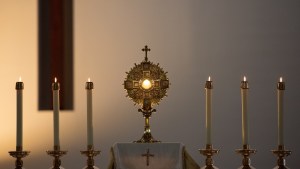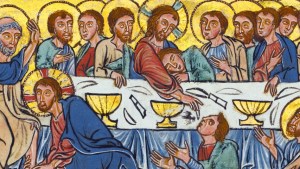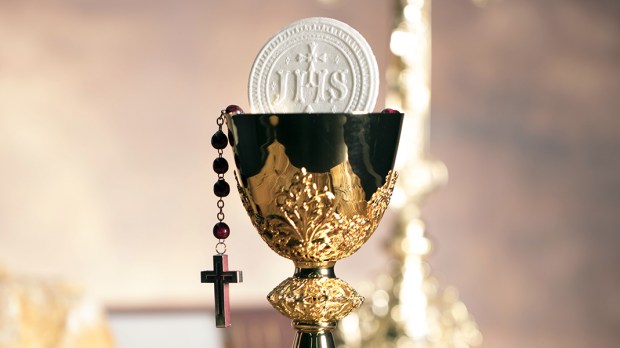This October, pray the Rosary every day to increase belief in the Eucharist.
There are many reasons to pray the Rosary: St. John Paul II called for daily Rosaries for peace and for the family. Pope Francis asked for Rosaries to protect the Church from the devil.
But St. Dominic was the first to call for Rosaries — to defeat the Albigensian heresy which, among other things, denied the Real Presence of Christ in the Eucharist. Let’s do the same.
The Rosary is profoundly Eucharistic.
You can hear echoes of the Eucharist throughout the Rosary. It is clearest in the Fifth Luminous Mystery, the Institution of the Eucharist, but it is everywhere, from the chalice in the Agony in the Garden to the Ascension promise, “Behold, I am with you always.”
But I think the Joyful Mysteries help illuminate the Eucharist most of all.
The First Joyful Mystery: The Eucharist and the Annunciation.
The Church teaches that Jesus Christ is truly present, body, blood, soul and divinity, in the Eucharist. The host just looks like bread — it has become the Body of Christ.
People may find it difficult to believe that Jesus Christ, son of the Living God, would be present in such a plain, undifferentiated way. But sustained reflection on the Annunciation mystery — the moment Mary became pregnant with Jesus Christ — solves that problem.
After all, the Annunciation is the moment that “the Word became flesh and dwelt among us.” We can learn from Mary’s attitude what the moment of consecration should be like: Humble gratitude and awe.

Read more:
Who do you say that I am? The current crisis of belief in the Eucharist
The Second Joyful Mystery: The Real Presence and the Visitation.
Another problem people might have with the Eucharist is the simple question, Why? Why would Jesus Christ want us to consume him in Communion? It seems odd.
But the answer to that question is actually very profound: “The Eucharist makes the Church,” as the Catechism puts it. We receive the body of Christ so that we can become the Body of Christ, doing his work in the world.
It couldn’t be clearer: We receive Jesus into our bodies, and then are dismissed out into the world to do his work.
Mary is the supreme example of this. In her “Visitation” to Elizabeth, Jesus Christ inside her animated her efforts to serve her cousin, and her cousin recognized the Lord present in her.
The Third Joyful Mystery: The Birth of Jesus and adoration.
But the Eucharist is not just something we receive in Communion. We also adore Jesus in the Blessed Sacrament in our churches.
Think of what it meant for shepherds to leave their flocks to adore an infant, or for the Magi to travel many miles to prostrate themselves before a baby’s crib. The very presence of Jesus, the Second Person of the Trinity, was enough to inspire grown men — and a host of angels —to gather around a sleeping baby. And his Real Presence in the sacrament is enough to gather us around the tabernacle today.
The Fourth Joyful Mystery: The Presentation and the Temple of our Bodies.
One of the earliest testimonies to the Eucharist is from St. Paul’s First Letter to the Corinthians. Paul recounts the Institution of the Eucharist and says it is vitally important to “discern the body” of Christ in Communion.
Later on in that letter, he gives a good reason why we need to be so careful with the Eucharist: Our bodies are “temples of the Holy Spirit,” he says.
The Fourth Joyful Mystery focuses on Mary and Joseph’s solemn Presentation of Jesus in the temple of Jerusalem. The care that they take to do what their faith prescribed is a good lesson for us: We need to bring Jesus into the temple of our own bodies with the same care.
And once we do, we can have the same reaction Simeon had after his encounter with Jesus: “Now you may let your servant go in peace … for my eyes have seen your salvation.”
The Fifth Joyful Mystery: Finding Jesus in the tabernacle.
But of all the joyful mysteries, the one where I find the most Eucharistic meaning in is the Finding of the Temple. In the original story, Joseph and Mary lose their son and look for him first among their family, who are returning from a pilgrimage to Jerusalem.
They don’t find him there, so they go back and there he is, in the Temple, sharing his wisdom with the teachers there.
This is a perfect analogy for what the Eucharist is for us. When we can’t find Jesus in our lives, there is one place we can always find him: In the tabernacle. There he waits, ready to ask and answer questions just as he did so many years ago.

Read more:
Why Thomas Aquinas believed the Eucharist is Jesus

